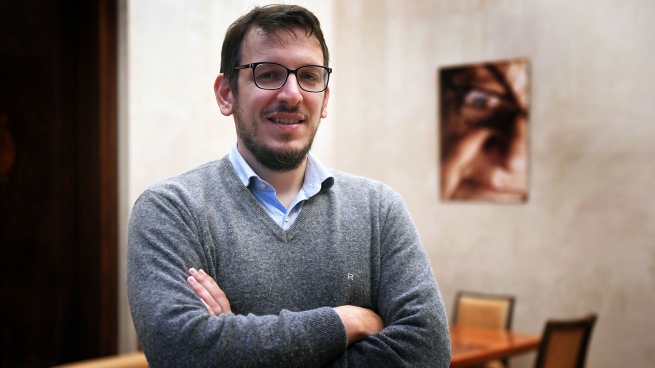A few days after the 200th anniversary of the founding of Banco Provincia de Buenos Aires, its president, Juan Cuattromo, assured that the entity is going through “a moment of great financial strength” with “unprecedented levels” since the end of convertibility, with a 75% customer growth in just three years and a structural transformation that allowed him to be at the forefront of a financial inclusion campaign for millions of people.
After years of compromised balance sheets, the leading bank in Latin America and the oldest company in Argentina is preparing to celebrate its 200-year history on September 6 with a proposal that includes discounts on purchases throughout September and a free music festival, which will take place on Saturday the 17th at the Estadio Único de La Plata.
In an interview with Télam, Cuattromo reviewed the milestones of his management that began in December 2019: the accelerated digitization of services, the impact of the pandemic, the financial inclusion work with new users, its link with the productive sector and the challenges slopes.
Here are the main excerpts from the interview:
– What evaluation do you make of these three years, of how you found the bank and how it is today?
– We found a bank with multiple challenges, both in the business of banking functions and from a more global and political point of view. We came from four years of the Macrista government, the last two particularly complex in macroeconomic matters, which affected the bank. However, today it is going through a moment of great financial strength, with unprecedented levels in the bank’s history, at least since it came out of convertibility: we have an excess of regulatory capital of almost 150% of what is required, very good levels of liquidity and we strongly reduced non-performing loans which, although still slightly higher than the rest of the system, fell more than the rest. The important thing is that we were able to carry out this structural transformation without losing sight of the axes that we have set for management: to grow strongly in productive financing in SME financing, to be close to the people of the province of Buenos Aires and to generate very important milestones. in terms of technological innovation. We are at a time that gives us satisfaction for what has been done but also with a lot of challenge for the future.
– How did this process take place and how did the pandemic affect you?
– To begin with, we understand that public banks can and should offer the same or better services than the rest of the financial system. But the role of public banking is not to maximize profit, but to offer the best services at the lowest possible cost. The pandemic accelerated an adaptation process that we knew we had to face, because the bank had many structural weaknesses. So the challenge was twofold: carry out a renewal process but from an initial situation that hid more weakness than we thought we would find. What we did was undertake a comprehensive transformation of the bank’s entire digital ecosystem. When we arrived, 60% of customers were not using digital channels. Today that relationship has been reversed: 70% are digital customers. It was a decisive transformation in how they relate to the bank since, in the number of transactions, today only 13% are face-to-face, and all this happened in two or three years. It was a very big challenge.
– Is this improvement reflected in the number of customers?
– Today we have 7.9 million customers in total, between individuals and companies, when in December 2019 we had 4.5 million. In other words, we grew almost 75% in clients. Of course, a lot of it was through the DNI Account, in segments that were not traditionally linked to a bank, much less a public bank. But also a lot in companies, businesses and professionals who, precisely, with proposals such as DNI Account and DNI Merchants Account we are bringing audiences that traditionally were not linked to the bank.
– What place did Account DNI occupy?
– All the bank’s actions have a commercial setback, but also a definition of public policy. One of the axes that Axel (Kicillof) set for the management of the bank is that it be a close bank, committed to the reality of the people of the province. That is, among other things, bringing this agenda of means of payment to all audiences. With Cuenta DNI we wanted an application that was up to or superior to what other banks or fintechs were offering, so that once people downloaded it and started using it they would realize that it really made sense to have it, beyond the IFE. Today DNI Account has 5.5 million users and we pay 1.4 million IFE. At a later stage, we understood that the next step was to have an application that would allow us to link businesses, especially those not included in the traditional financial system, such as street vendors and monotributistas. That is why we launched at the beginning of this year DNI Merchants Account, which is our collection application with the lowest commissions in the entire system, equal or better services, and which we complement with a very active training proposal. That obviously appealed to different audiences.
? Schedule all the benefits you have with #AccountDNI?? in the month of our Bicentennial!
? From Tuesday 6 to Thursday 8
?45% savings at participating locations.
Cap $1800 per term and per person.Follow in thread ? pic.twitter.com/9vN08BF4GX
– Provincial Bank (@bancoprovincia) September 1, 2022
– What strategies did you implement to attract these new customers?
– Basically we developed a discount strategy designed as a public policy. When Axel was a candidate and toured the province, the “Super 50” was very present (a 50% discount promotion in large supermarkets launched during the government of María Eugenia Vidal) and the merchants who approached us always told us the same thing, that they we would forget about them, because it was very difficult to compete with a discount like this anchored in large surfaces. For this reason, the discounts are based on the fact that the benefit is greater in nearby stores than in large supermarkets. Paradoxically, this action generated great recognition for us, since of the 50,000 points of sale in Buenos Aires that accept DNI Accounts, 40% already charge with DNI Merchants Accounts. It is a very large growth in only eight months that implies brand recognition from the fact that people demand that the business have a DNI Account.
– What is the bank’s link with the countryside and industry?
– One of our central definitions is to be a development bank and linked to production. When we arrived at the bank, it had a participation in all the credit of companies that was more or less around 7%. Now it is close to 11.5%. We grew more than the rest of the system and that has to do with our definition of operating with a bank that is very close to production, from a strategy of very competitive rates for the productive sectors but, at the same time, from this logic of proximity, with periodic meetings with the different sectors and regions of the province to understand what specific needs they have and what tools the bank has to generate. The political definition of our governor is to finance production and build tools as a whole. It is the tradition that we want to vindicate from Banco Provincia.
DNI account, the digital wallet that 1 out of 3 people from Buenos Aires already have
Since its relaunch in April 2020, Banco Provincia’s digital wallet, Cuenta DNI, has incorporated more than 5.4 million users, reaching 34% of the inhabitants of the province of Buenos Aires over 13 years of age and granted more than $89,000 million in discounts on consumption with promotions through the application.
Of that amount, .000 million were financed with contributions from the Ministry of Treasury and Financewithin the framework of the discount program in force between July 2021 and February 2022.
In this regard, Juan Cuattromo, head of Banco Provincia, stressed that applications such as DNI Account allow “to demonstrate to users, be it the one who pays or the business that collects, that the system is transparent, reliable and secure,” so “if tool is superior to cash, sooner or later, you’re going to beat it.”
“In fact, the use of cash drops dramatically in most people who start paying with their cell phones, because they realize that it is a solution to going to the ATM to pay in cash and an irreversibility occurs. It is a task even a demonstration that must be built,” he assured in dialogue with Télam.
“One way to deepen this path is with the 40% discount every day in September at fairs and markets in Buenos Aires with a DNI Account. There we target vendors who, many times, are informal and only use cash, so they can see that when they collect the money, it is credited at the time, in a very transparent and simple way,” explained Cuattromo
In this regard, he added: “For users, who would not think that going there they could pay with their cell phone, they find a 40% discount. We aim that this generates an adaptation of both the business and the users.”
To celebrate its bicentennial, Banco Provincia will offer discounts of up to 45% through its digital wallet and credit cards.
The benefit with DNI Account will be extended from September 6 to 8 and will have a cap of 1,800 pesos per person; while card savings will apply on Tuesday 6 and Wednesday 7, with a limit of 3,500 pesos per transaction.
In addition, in September the usual DNI Account promotions will continue, which include savings in neighborhood businesses in the food sector, businesses that operate with the DNI Business Account, supermarkets, fairs and markets, and the exclusive promotion for the segment of young people between 13 and 17 years.









